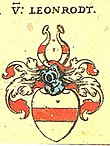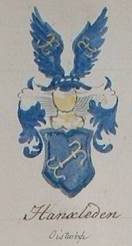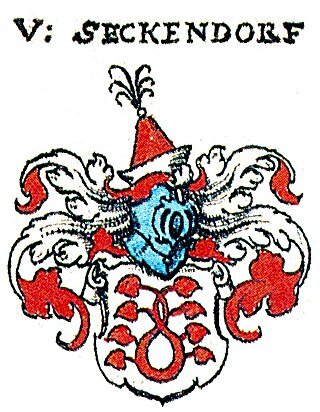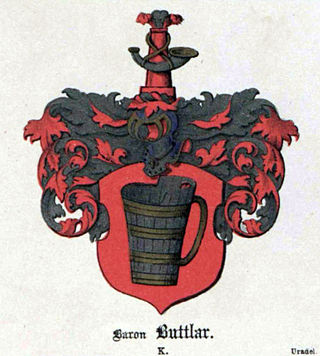| Leonrod | |
|---|---|
| Noble house | |
 House of Leonrod coat of arms | |
| Country | Franconia, Swabia |
| Founder | Philipp von Leonrod |
| Estate(s) | Leonrod |
| Dissolution | 1952 |
The Leonrod (or Leonrodt) family was a Franconian - Swabian noble family that died out in 1951.
| Leonrod | |
|---|---|
| Noble house | |
 House of Leonrod coat of arms | |
| Country | Franconia, Swabia |
| Founder | Philipp von Leonrod |
| Estate(s) | Leonrod |
| Dissolution | 1952 |
The Leonrod (or Leonrodt) family was a Franconian - Swabian noble family that died out in 1951.

The noble family's ancestral seat was the Leonrod Castle, a moated 13th century castle located on the southwestern outskirts of Leonrod near Dietenhofen.
Burial places, along with epitaphs and coat of arms engravings of many Leonrod family members can still be found in the Dietenhofen church and Maria Kappel church in Schmiechen.
Many generations of the Leonrod family served the Teutonic Order. Several family members became high spiritual dignitaries in the diocese of Eichstätt. The noble line were later elevated to imperial Franconian knights.
The Leonrod family name can be found in several toponyms in modern Germany:
The Leonrod coat of arms is a red bar on the silver field. On the helmet with red and silver covers, there are two horns marked in the same way as the shield.

The House of Hohenzollern is a formerly royal German dynasty whose members were variously princes, electors, kings and emperors of Hohenzollern, Brandenburg, Prussia, the German Empire, and Romania. The family came from the area around the town of Hechingen in Swabia during the late 11th century and took their name from Hohenzollern Castle. The first ancestors of the Hohenzollerns were mentioned in 1061.

Bad Mergentheim is a town in the Main-Tauber-Kreis district in the German state of Baden-Württemberg. It has a population of around 23,000. An officially recognized spa town since 1926, Bad Mergentheim is also known as the headquarters of the Teutonic Order from 1526 until 1809.

The House of Schwarzenberg is a German (Franconian) and Czech (Bohemian) aristocratic family, formerly one of the most prominent European noble houses. The Schwarzenbergs are members of the German and Czech nobility, and they once held the rank of Princes of the Holy Roman Empire. The family belongs to the high nobility and traces its roots to the Lords of Seinsheim during the Middle Ages.

The House of Bibra was one of the leading Uradel families in Franconia and present day Thuringia from the mid-15th century to about 1600. Later on the family rose from Reichsritter to Reichsfreiherr. After the Holy Roman Empire dissolved, they were made ‘’Freiherr’‘ (Barons) of Bavaria and Bohemia.

Dietenhofen is a municipality in the district of Ansbach in Bavaria, Germany.

The House and Merit Order of Duke Peter Frederick Louis or proper German Oldenburg House and Merit Order of Duke Peter Frederick Louis was a civil and military order of the Grand Duchy of Oldenburg, a member state of the German Empire. The order was founded by Grand Duke Augustus of Oldenburg on 27 November 1838, to honor his father, Peter Frederick Louis of Oldenburg. It became obsolete in 1918 after the abdication of the last grand duke.
The House of Guttenberg is a prominent Franconian noble family. It traces its origins back to 1149 with a Gundeloh von Blassenberg (Plassenberg), though the first mention in a document is dated 1158. The name Guttenberg is derived from Guttenberg in present-day Bavaria, and it was adopted by a Heinrich von Blassenberg around 1310.

Raitz von Frentz is the name of a baronial (freiherrlichen) family, that belongs to the German ancient nobility (Uradel). The Barons Raitz von Frentz should be distinguished from the dynastic family "von Frenz", a branch of the Dukes of Limburg, that became extinct in the 14th century.

The Hanxleden family is a Westphalian noble family whose seat is the village of Hanxleden, today part of Schmallenberg in the district of Hochsauerland in Germany. In the 14th and 15th centuries the family provided several bailiffs (Amtmänner) of Fredeburg.

The House of Franckenstein is the name of a feudal, Franconian noble family in Germany, descendants from the Dynasts of the Breuberg family; offsprings of the Lords of Lützelbach from Höchst im Odenwald.

Cronheim is a village in the municipality of Gunzenhausen in the Weißenburg-Gunzenhausen district which forms part of the Bavarian Government district of Mittelfranken. The hamlet of Filchenhard forms part of Cronheim.

Count Frederick IV of Oettingen was archbishop of Eichstätt from 1383 until his death.

Leonrod is a village in the borough of the market town of Dietenhofen in the district of Ansbach, Middle Franconia, Germany.
Leonrod may refer to:

The House of Seckendorff is the name of an old and prolific Franconian noble family. According to historian Werner Wagenhöfer, the Seckendorff family is the most researched family of the low nobility in Franconia along with the Guttenberg and Bibra families.

The House of Egloffstein is an ancient Franconian aristocratic family (Uradel) with an eponymous family home in the hill region of Franconian Switzerland in the Bavarian province of Upper Franconia. The family first appears in the records in 1187 with a Heinrich genannt Stuchs who is also the progenitor. The house belongs to the brotherhood of Franconian Imperial Knights. Egloffstein Castle and Kunreuth Castle are to this day owned by the family.

The Buttlar family is the name of an old Upper Franconian-Hessian noble family. The lords of Buttlar originate from the ancient nobility of Buchonia. Branches of the family also reached Westphalia, Saxony, Prussia, Curonia, France, Poland, Russia and Hungary, and remain partly to this day. The Buttlar and Treusch von Buttlar families of Hessen has since 1660 belonged to the Old Hessian Knighthood, the oldest foundation in Hessen.

Falke is an ancient German noble family (Uradel). The name is originally spelled Falcken, Falken, Falkenreck, also Falken-Reck.

The Frydag family, also spelled Vrydach, Freytag, Freydag and various other slightly different spellings, is a German noble family known since the beginning of the 14th century that originated in Uradel in Westphalia.

Heinrich von Bobenhausen was the 41st Grandmaster of the Teutonic Knights, reigning for close to two decades from 1572 to 1590.